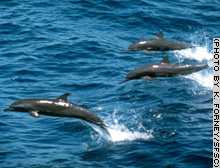|
3,000 dolphins killed yearly by fishing in eastern tropical Pacific
By JOHN HEILPRIN
Wednesday, December 4, 2002
Courtesy CNN
About 3,000 dolphins are still being killed each year by tuna fishing fleets in the Pacific Ocean west of Mexico and Central America, a government report says.
The report estimates about 6 million dolphins were killed in this fashion in the eastern tropical Pacific since the 1950s, and that while the annual death toll has dropped significantly in recent years, the dolphin's recovery remains in doubt.
A spotted dolphin and two spinner dolphins
leap in this image from a 2001 NOAA expedition
"Despite considerable scientific effort by fishery scientists, there is little evidence of recovery, and concerns remain that the practice of chasing and encircling dolphins somehow is adversely affecting the ability of these depleted stocks to recover," the report says.
The report was prepared in August by the Southwest Fisheries Science Center of the Commerce Department's National Oceanic and Atmospheric Administration.
An environmental group, Earth Island Institute of San Francisco, obtained the report and provided it to The Associated Press on Wednesday. The report has not yet been released publicly by the Commerce Department.
The group said in a statement that it believes the Bush administration doesn't want to publicly release the report because that would undermine the government's attempt to help Mexico and other countries label their tuna as "dolphin-safe."
A court ruling in the United States last year effectively rejected a federal effort to relax standards of dolphin-safe tuna that would have let more Mexican and Latin American fishing fleets sell their catch in the United States.
The Clinton administration, hoping to promote trade with Mexico, argued that the tuna should be labeled dolphin-safe because U.S. government studies found that the dolphins were released unharmed but environmental groups sued.
Mexican authorities maintain that their tuna catches do not pose a threat to dolphins.
In recent years, canning and processing industries in the U.S., Canada and many European countries have said that they won't market tuna unless it is caught in a way that doesn't harm dolphins.
Gordon Helm, a spokesman for the National Marine Fisheries Service, a branch of the Commerce Department, said Wednesday that the report was completed and peer-reviewed, but not yet ready to be made public since it was still being reviewed by Commerce Secretary Don Evans.
"Any discussion of the report before the secretary makes his decision would be premature," Helm said.
Evans has until Dec. 31, a deadline set by Congress, to review the report along with public comments and other supporting documents. He is required to conduct scientific research and then decide whether the large nets used by the tuna fleets is significantly harming the depleted dolphin populations in the eastern tropical Pacific.
On the Net:
NOAA:
http://www.nmfs.noaa.gov/prot_res/PR2/Tuna_Dolphin/IDCPAresearch.html
Earth Island Institute:
http://www.earthisland.org/home_body.cfm
|
